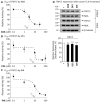Tricyclic antidepressants dose-dependently modulate the biphasic activity of the TRPC5 channel through opioid receptors
- PMID: 40551090
- PMCID: PMC12198451
- DOI: 10.4196/kjpp.25.121
Tricyclic antidepressants dose-dependently modulate the biphasic activity of the TRPC5 channel through opioid receptors
Abstract
Tricyclic antidepressants (TCAs) have been widely used for the treatment of major depressive disorder and other psychiatric conditions. However, their clinical application has declined due to adverse side effects and the availability of newer antidepressants with improved safety profiles. TCAs primarily target serotonin and norepinephrine receptors but also interact with a variety of other receptors and ion channels, contributing to both their therapeutic and adverse effects. We previously reported that TCAs regulate transient receptor potential canonical type 4 (TRPC4) channels. In this study, we investigated whether TCAs similarly modulate TRPC5 channels. Using HEK293 cells overexpressing TRPC5, we measured TRPC5 currents and intracellular calcium levels. Without altering TRPC5 expression levels, TCAs (amitriptyline, desipramine, and imipramine) dose-dependently reduced inward currents through TRPC5, with IC₅₀ values of 2.9, 10.3, and 11.7 μM, respectively. Given that TCAs can act as off-target agonists at opioid receptors (ORs), we co-expressed TRPC5 with various OR subtypes (μ-, δ-, and κ-ORs). Our results revealed that at low concentrations, TCAs enhanced TRPC5 activation through OR stimulation, whereas at higher concentrations, competitive inhibition of TRPC5 activity predominated. The biphasic modulation of TRPC5 by TCAs may contribute to a wide spectrum of cardiovascular and neurological manifestations, depending on the dosage and clinical application. Overall, these findings enhance the pharmacological understanding of the molecular mechanisms underlying the actions of TCAs and emphasize the need for more targeted therapeutic approaches.
Keywords: Biphasic; Depression; Opioid receptor; TRPC5; Tricyclic antidepressant.
Conflict of interest statement
The authors declare no conflicts of interest.
Figures




Similar articles
-
Pharmacological treatments in panic disorder in adults: a network meta-analysis.Cochrane Database Syst Rev. 2023 Nov 28;11(11):CD012729. doi: 10.1002/14651858.CD012729.pub3. Cochrane Database Syst Rev. 2023. PMID: 38014714 Free PMC article.
-
Antidepressants versus placebo for panic disorder in adults.Cochrane Database Syst Rev. 2018 Apr 5;4(4):CD010676. doi: 10.1002/14651858.CD010676.pub2. Cochrane Database Syst Rev. 2018. PMID: 29620793 Free PMC article.
-
Antidepressants for chronic non-cancer pain in children and adolescents.Cochrane Database Syst Rev. 2017 Aug 5;8(8):CD012535. doi: 10.1002/14651858.CD012535.pub2. Cochrane Database Syst Rev. 2017. PMID: 28779487 Free PMC article.
-
Antidepressants for the treatment of depression in people with cancer.Cochrane Database Syst Rev. 2018 Apr 23;4(4):CD011006. doi: 10.1002/14651858.CD011006.pub3. Cochrane Database Syst Rev. 2018. Update in: Cochrane Database Syst Rev. 2023 Mar 31;3:CD011006. doi: 10.1002/14651858.CD011006.pub4. PMID: 29683474 Free PMC article. Updated.
-
Tricyclic antidepressants for autism spectrum disorders (ASD) in children and adolescents.Cochrane Database Syst Rev. 2012 Mar 14;2012(3):CD008372. doi: 10.1002/14651858.CD008372.pub2. Cochrane Database Syst Rev. 2012. PMID: 22419332 Free PMC article.
References
-
- Moraczewski J, Awosika AO, Aedma KK. Tricyclic antidepressants. StatPearls Publishing; 2025. - PubMed
-
- Vos CF, Aarnoutse RE, Op de Coul MJM, Spijker J, Groothedde-Kuyvenhoven MM, Mihaescu R, Wessels-Basten SJW, Rovers JJE, Ter Hark SE, Schene AH, Hulscher MEJL, Janzing JGE. Tricyclic antidepressants for major depressive disorder: a comprehensive evaluation of current practice in the Netherlands. BMC Psychiatry. 2021;21:481. doi: 10.1186/s12888-021-03490-x. - DOI - PMC - PubMed
LinkOut - more resources
Full Text Sources
Research Materials

